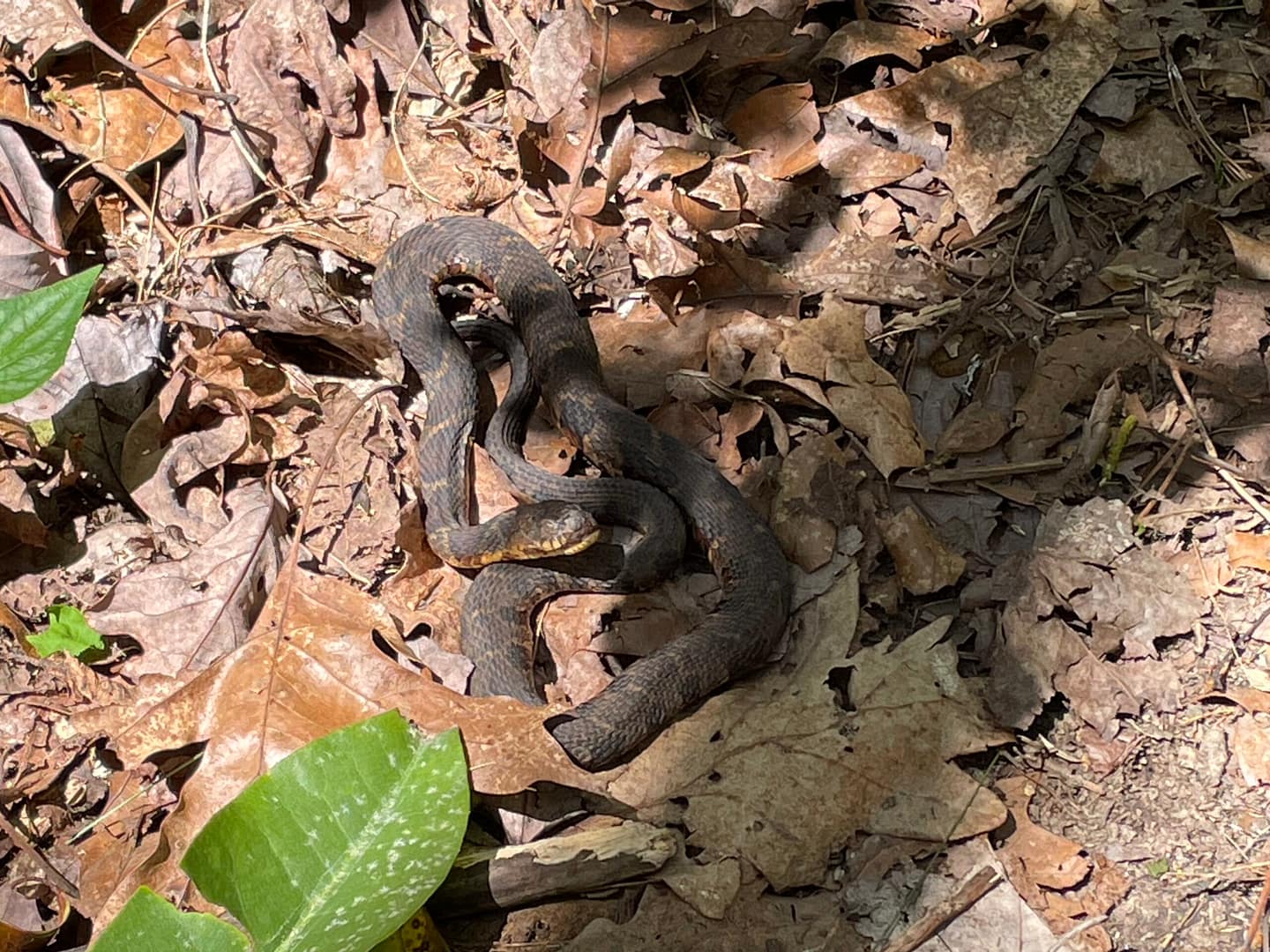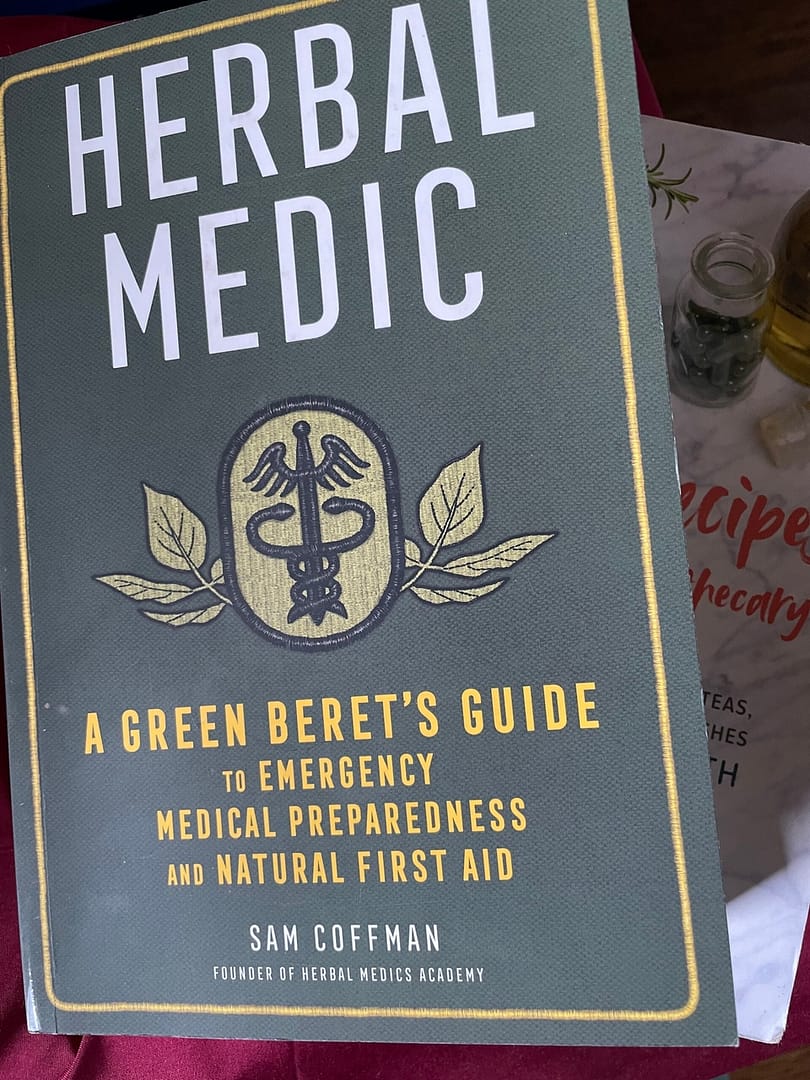Here in Northeast Georgia, it is not uncommon to see snakes. I have seen black snakes, ring-necked snakes, red bellied snakes, Northern water snakes, and other non-venomous varieties of this creature – both on trail and off.
Of the venomous varieties, rattlesnakes and copperheads are the most common here in the mountains. I have yet to see a rattlesnake in this part of Georgia. However I have seen more than a few copperheads on various trails over the years. I have even seen two copperheads on the road in my neighborhood as I walked my dog. Yes, I am certain they were copperheads; they had the tell-tale Hershey’s kisses on their sides.
And I know that there are countless snakes which I have hiked right past
without ever knowing they were there,
next to the trail,
watching me.
[Cue the scary music in my head and imaginary creepy crawlies in my skin.]

Thankfully, I have never been bitten by any snake, let alone a venomous one. I do personally know someone who was bitten by a copperhead a couple of years ago. Compared to falls, heat exhaustion, and other emergencies, the risk of being bitten by a venomous snake is not high. The risk of death from such a bite is almost nil.
Still, as someone who enjoys hiking, camping, and living in Northeast Georgia; and as someone who leads a hiking group; it only makes sense to at least have a plan for dealing with snakebites.
Some of these links in this post are affiliate links. See full disclosures here.
“Seek Medical Attention “
As I researched this topic, the official consensus for treating a venomous snakebite seems to be: Keep the patient as calm and as still as possible while immediately heading to the hospital. That is it.
Ice, tourniquets, venom extraction tools, elevating or lowering the extremity – all of these are reported to have possibly helped in a few cases or, in many cases, have definitely caused more damage to the affected tissues.
For those who are in the cities or the suburbs (and who still trust the medical profession), the advice to “seek medical attention immediately” is somewhat reasonable. They are within easy driving distance of a hospital.
If the local hospital has anti-venom (not all do), they may be able to administer that. Anti-venom is outrageously expensive ($15K for one dose with multiple doses required) and comes with its own set of potential risks including anaphylactic shock. However even if one chooses not to use anti-venom, the hospital staff may be able to use pharmaceuticals to help ease the symptoms and prevent complications.
The real challenge comes when we are camping or hiking in remote areas.
What happens if I am hiking and get bitten by a rattlesnake or copperhead? Do I just have to suffer as I hike miles to the nearest trailhead? Should I wait for emergency crews to come rescue me? Many of the trails I hike have spotty cell service at best. I could literally be waiting HOURS. Is there anything I can do in the meantime?
I believe there is.
Below are two approaches I have researched.
Herbs
I recently participated in an herb class in which the instructor definitively stated that there are no plants which can help a venomous snake bite. I found that rather interesting since there are herbalists who have used plants in clinical practice to do just that.
Are those herbalists quacks and liars? I do not believe so. But no treatment is ever 100% effective for every individual. With snake bites being so rare, it stands to reason that few herbalists will have extensive experience in this area. Perhaps that explains this instructor’s stance? I can only guess.
Even with no guarantee, I prefer to have SOMETHING on hand that might help (and will not cause more damage) rather than doing nothing. So I looked at two herbalists who have published information on this topic.
Two Herbalists
First, Dr. Patrick Jones is not only an herbalist, he is a veterinarian. As such, he has been able to treat cases not generally seen by other herbalists. That includes rattlesnake bites. On this topic he has provided free videos like this one and this one. He also offers this module in his online herbal school specifically addressing bites and stings in depth. I have not yet purchased that module, though I have participated in webinars he offered and purchased herbs from him. Be warned: he sprinkles all of his videos with cheesy dad jokes. Haha!
Second, Sam Coffman is a former Green Beret medic who is also trained to use herbs. He has over 25 years of field experience and shares much of his knowledge in the book, The Herbal Medic. This covers basic first aid, trauma & wound care, and more with an eye towards plant medicines rather than pharmaceuticals. The section on snakebites is quite thorough and includes recommendations for supporting affected organs in the days following. I highly recommend that you keep this resource on hand not only for snakebites, but for general emergency preparedness both at home and on the trail.
Homeopathy
Though many herbalists will occasionally use homeopathic remedies, homeopathy is a completely different discipline from herbalism. It is based upon the premise that like cures like.
For example, if someone is having a histamine reaction, rather than prescribe an anti-histamine pharmaceutical or herb, a homeopath would recommend a remedy which contains a substance which causes a histamine reaction. It sounds a little crazy, but it works for many people. The remedies are highly diluted and serve as a sort of jump-start for the body to heal itself.
Some herbalists use a homeopathic approach for things like poison ivy (including the instructor I mentioned above). I personally know people who have used this approach successfully not only for poison ivy, but for seasonal allergies and other complaints. Even some friends who were initially skeptical admitted that their symptoms were alleviated by homeopathic remedies.
In my research on venomous snakebites, I visited The Faulkner School online as well as a few other sites. Again, most of the homeopaths who have clinical experience with snakebites have only used it in veterinary applications including two foals and an 11 year old dog. Why is that? We can only speculate. Still, there was documented improvement afterward.
The examples I found all employed a handful of remedies based on the symptoms presenting themselves at any given moment. One homeopathic remedy in particular is created from snake venom and was used consistently. The other remedies were for things like puncture wounds, shock, and nerve damage.
My Kit
Based upon that research, I have assembled my own venomous snakebite kit. The most important component is a list of procedures. Thinking this through while calm is a beneficial mental exercise and a way to practice my skills. However, the printed list is intended to help me remember the important points in the field, when seconds count.
The procedures page lists basic things like removing jewelry and restrictive clothing and marking any swelling and redness with a marker to track growth. Much of that information came from The Herbal Medic. I also included a list of assignments for other members of our hiking group as well as a checklist of items to assess on the patient every 15 minutes.
The members of our group may not wish to use herbal or homeopathic remedies. That is fine. The basic snakebite emergency procedures will still apply.
For myself or anyone who does wish to use herbal and/or homeopathic remedies, I have printed information on how and when to administer the ones I carry. The remedies I have selected include small bottles of herbal tinctures, baggies of powdered herbs, activated charcoal capsules, and a handful of homeopathic remedies.
All of this: the remedies, lists, instructions, paper, pen, and even a measuring spoon are all contained in one, quart-size zipper bag. It is stashed alongside my booboo kit and my trauma kit.
Your Kit
I considered sharing more details regarding the contents of my kit. However, I am a home educating mom. As such, I realize the value of thinking through procedures and creating a kit customized to the needs of YOUR family or group. If you ever need to use the kit, you need to know exactly what it contains and how to use it. Below is a list to get you started creating your own.
Getting Started:
- Assess the risks in your area. What are you likely to encounter? How long might it take you to reach emergency medical help?
- Assess your responsibilities. Do you lead a group? More people = more risks. Are you leading adults or unaccompanied minors? Adults bear their own responsibilities; children depend the leader when a parent is not present.
- Make a procedural list of what to do in the event that someone is bitten by a snake (of any type).
- Determine what sort of remedies you would be willing to use for yourself and your family. Do you prefer pharmaceuticals? Are you comfortable using herbs and/or homeopathy? Are there other healing disciplines and modalities you trust?
- Research the types of remedies you would like to keep on hand for yourself and your family. Determine which ones you are willing to carry and use in the field. Learn how to administer them.
- Assemble the contents of your kit including instructions and tools for dosing. For example, if you plan to use liquids, you will likely need a measuring spoon. Also, do not depend on internet access for dosing instructions or metric conversions.
- Most importantly: carry the kit in your hiking bag. It does no good sitting at home.
If you prefer to use herbs but are not yet comfortable making your own tinctures and poultices, Doc Jones does sell a Cut, Bite, & Sting Kit which you could use as a foundation. If you decide to purchase that, you will still need to familiarize yourself with the contents, add any additional remedies you prefer, and establish your own procedures list.
Comment & Share
Have you considered what you would do in the event that you or someone in your group gets a snakebite? What are your plans?
Do you have experience with venomous snakebites?
Please share your plans and experiences in the comments.


